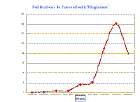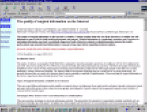|
Plagiarism
In The New Age
Priyanka
P. Doctor
|
|
Internet
Health 2003;2:4
INTRODUCTION
Academic plagiarism is a thorny ethical and practical problem.
Perhaps readers have never personally encountered or recognized a
case of plagiarism so its immediate interest and relevance may be
obscure. The Internet is an invaluable tool for researchers and
certainly also a source of inspiration. However, never before has it
been so easy to plagiarise the work of others.[1]
PLAGIARISM
DEFINED
According to the
Merriam-Webster Online Dictionary, to "plagiarize" means
1) to steal and pass off (the ideas or words of another) as one's
own
2) to use (another's production) without crediting the source
3) to commit literary theft
4) to present as new and original an idea or product derived from an
existing source.
 |
Plot of the
number of articles on Pubmed carrying 'Plagiarism'
[Click
on image to enlarge]
|
The St. Martin's
Handbook defines plagiarism as "the use of someone else's words
or ideas as [the writer's] own without crediting the other
person" (Lunsford and Connors 602).
In other words, plagiarism is an act of fraud. It involves both
stealing someone else's work and lying about it afterward.
HOW &
WHY
Medline[2] is an example of a tool providing huge amounts of
information at the click of the 'search' bar. Other internet search
engines such as Yahoo![3], Google, [4] AltaVista [5]provide hits on
any conceivable subject. Each month about 25 million users of the
World Wide Web (WWW) access information from Yahoo! At an average
rate of 50 million web pages per day - a larger audience than
magazines such as Newsweek or Time.[6]
According to a survey by the Psychological Record 36% of
undergraduates have admitted to plagiarizing written material. [7]
Students and researchers find it even easier to get away with the
attitude taken by the academic community : "Who wants to sit
around looking for websites trying to find out if a paper is
plagiarized or not... pretty soon you're a private
investigator." -- a Stanford University professor, from an
article in TechWeb News.[8]
Before the Internet, cheating was time consuming and potential
plagiarists had to find appropriate works from a limited pool of
resources, usually a nearby library, and copy them by hand. Since
these resources were almost always professionally written, the risk
of detection was very high. With the Internet, a simple 'Cut…
Copy…. Paste…. ' will do the job. Moreover, the threshold of
stealing ideas, whether lifting paragraphs or perhaps even whole
articles from the Internet, seems to be much lower than copying
sections from books or articles.[1]
A CASE STUDY
On 5 August 1999, a paper titled "The quality of surgical
information on the Internet" (see figure below) was published
in the Journal of the Royal College of Surgeons of Edinburgh (JRCSEd)[1].
The JRCSEd is a journal indexed in several bibliographical databases
including Biological Abstracts, EMBASE, Current Contents, Index
Medicus/MEDLINE, and others. After publication, it was determined
that more than one third (36%) of this article consisted of phrases
that were directly copied from multiple websites, without giving
attribution to this fact. [9,1]
 |
The
online version of the questionable article, which contained
lifted phrases from the web, as published in the Journal of
the Royal College of Surgeons of Edinburgh
[Click on
image to enlarge]
|
CRACKING
DOWN
Yet, all is not bleak. In order to detect plagiarism, one may
copy-paste the matter (or a part of it) in the search window at
Findsame.[10] This search engine turns up a list of Web pages that
have sentences or whole paragraphs matching your entry.
Alternatively, one may type some keywords or unusual phrases from
the assignment into any of the search engines like Google[4] or Alta
Vista[5]. This would usually turn up the source document, as
students usually look for information this way. Plagarized.com[11]
is a forum for educators concerned about Internet plagiarism. Though
rather US-oriented, Indian academicians too would find the articles
and advice on the site very useful. Turn It In[12] is a paid service
that gives a "document source analysis" for a given
assignment. This program checks its local database containing
thousands of academic papers, as well as searches the Web for
possible matches. It then gives an "originality report"
with complete colour-coded links for each paper. Word Check
Systems[13] is a unique software that allows you to create an
archive of papers, journals and assignments submitted in the past.
When you enter a suspect document into it, the program scans the
entire database and brings up matching documents, if any. The
Internet can also provide ways and means to identify unintentional
omissions of attributions and for journal editors and peer-reviewers
to detect plagiarism.[12]
TIPS TO
AVOID COMMITING PLAGIARISM
 |
Cite every piece of information that is not a) the result of your
own research, or b) common knowledge. This includes opinions,
arguments, and speculations as well as facts, details, figures, and
statistics.
|
 |
Use quotation marks every time you use the author's words. (For
longer quotes, indenting the whole quotation has the same effect as
quotation marks.)
|
 |
At the beginning of the first sentence in which you quote,
paraphrase, or summarize, make it clear that what comes next is
someone else's idea:
· According to
Smith...
· Jones says...
· In his 1987
study, Robinson proved...
|
 |
At the end of the last sentence containing quoted, paraphrased,
or summarized material, insert a parenthetical citation to show
where the material came from:
|
(Notice the use of brackets to mark a change in the wording of the
original.) [14]
REFERENCES
1. Eysenbach G. Report of a case of cyberplagiarism - and
reflections on detecting and preventing academic misconduct using
the Internet.J Med Internet Res 2000:1;e4 [Full Text Online at:http://www.jmir.org/2000/1/e4/index.htm]
2. Medline [http://www.nlm.nih.gov/]
3. Yahoo! [http://www.yahoo.com/]
4. Google [http://www.google.com/]
5. AltaVista [http://www.altavista.com/]
6. Yahoo!'s U.S. Audience Surpasses 25 Million, Outpacing Leading
Broadcast and Print Media. 1997 Nov. [http://www.yahoo.com/docs/pr/release131.html]
7. Roig M. Psychological Record. 1997;47:113-122
8. Plagiarism On The Web Is As Easy As 1-2-3 , September 9, 1999
[http://www.techweb.com/wire/story/backtoschool/TWB19990909S0003]
9. McKinley J, Cattermole H, Oliver CW. The quality of surgical
information on the Internet. J R Coll Surg Edinb. 1999
Aug;44(4):265-8. [Medline
Abstracts]
10. Findsame [http://www.findsame.com]
11. Plagiarized.com [http://www.plagiarized.com/]
12. TurnItIn [http://www.turnitin.com/]
13. Word Check Systems [http://www.wordchecksystems.com/]
14. Some tips for avoiding accidental plagiarism when you use
sources: Avoiding Plagiarism [http://www.writing.nwu.edu/tips/plag.html]
|

 © Copyright of articles belongs to the
respective authors. Verbatim
copying, redistribution and storage of this article permitted provided no
restrictions are imposed on the access and a hyperlink to the original article
in Internet Health maintained. The author would be interested in critical
appraisal of this article. Please contact him at the correspondence e-mail
provided. All opinion stated in this article are exclusively that of the
author(s). Internet Health takes no responsibility of articles published. Please
read carefully the Terms and Conditions of use and disclaimer notice
.Information in Internet health is not a substitute for your Physician's advice.
© Copyright of articles belongs to the
respective authors. Verbatim
copying, redistribution and storage of this article permitted provided no
restrictions are imposed on the access and a hyperlink to the original article
in Internet Health maintained. The author would be interested in critical
appraisal of this article. Please contact him at the correspondence e-mail
provided. All opinion stated in this article are exclusively that of the
author(s). Internet Health takes no responsibility of articles published. Please
read carefully the Terms and Conditions of use and disclaimer notice
.Information in Internet health is not a substitute for your Physician's advice.![]()
![]()
![]()
![]()
![]()


